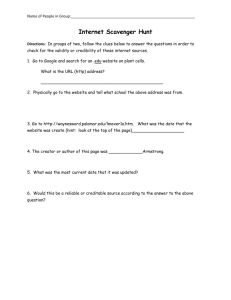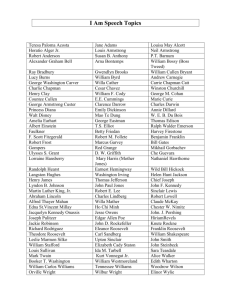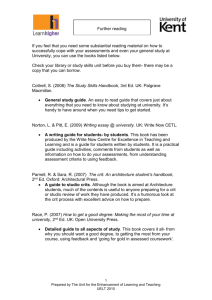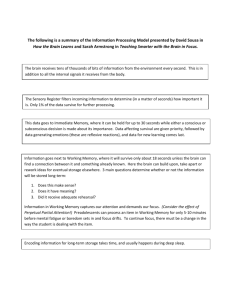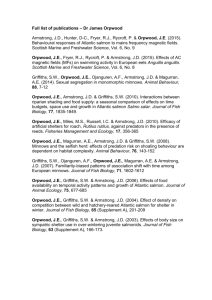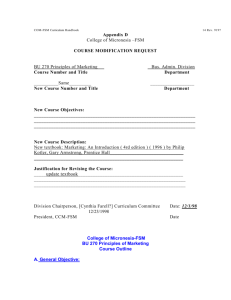Slide - community360.net
advertisement
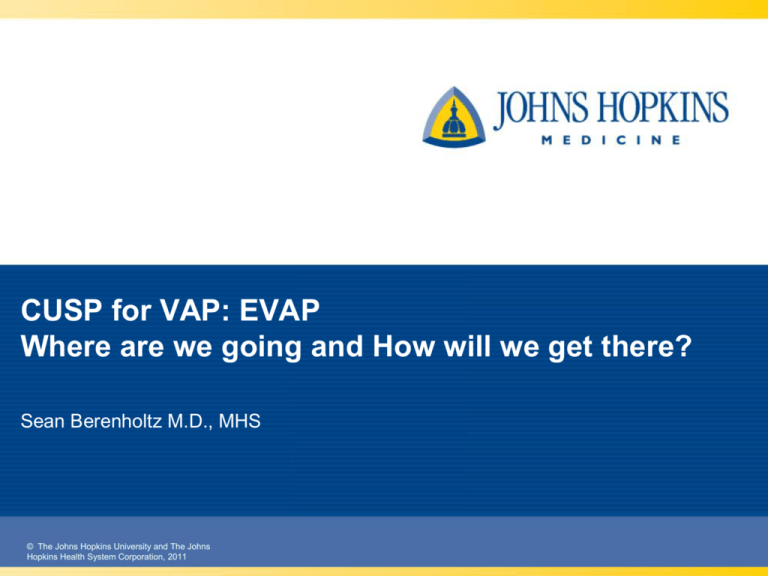
CUSP for VAP: EVAP Where are we going and How will we get there? Sean Berenholtz M.D., MHS © The Johns Hopkins University and The Johns Hopkins Health System Corporation, 2011 3 Armstrong Institute for Patient Safety and Quality Healthcare-Associated Infections (HAI): A Preventable Epidemic • Focus on 4 HAIs: – VAP, CLABSI, surgical site infections and catheter associated urinary tract infections • $5 billion per year excess costs • 1.7 million patients per year – 1 out of 20 patients • 98,000 deaths per year – As many deaths as breast cancer and HIV/AIDS – 6th leading cause of preventable deaths Waxman HA. Hearing of April 16, 2008 4 Impact of VAP • 10-20% of ventilated patients • Common HAI – Median rate 1-4.3 per 1000 vent day – 250,000 infections per year • Most lethal HAI – Mortality likely exceeds 10% – Up to 36,000 deaths per year • Cost per episode: $23,000 Safdar CCM 2005, Kollef Chest 2005, Perencevich ICHE 2007, Klevens Public Health Rep. 2007. Project Overview • NIH/NHLBI and AHRQ funding project – Individual hospitals participate for 3 years, including 2 year intervention period and 1 year evaluation of sustainability • Leveraging leaders in field – Armstrong Institute for Patient Safety and Quality, NIH/NHLBI, CDC, AHRQ, University of Pennsylvania, MHA and HAP – MD and PA hospitals 6 Armstrong Institute for Patient Safety and Quality Project Goals • To achieve significant reductions in VAP/VAE rates • To achieve significant improvements in safety culture How will we get there? http://www.hopkinsmedicine.org/armstrong_institute Successful Efforts to Reduce Preventable Harm • Michigan Keystone ICU program – Reductions in central line-associated blood stream infections (CLABSI) 1,2 – Reductions in ventilator-associated pneumonias (VAP) 3 • National On the CUSP: Stop BSI program 4 1. 2. 3. 4. Pronovost P, N Engl J Med 2006;355:2725-32. Pronovost P, BMJ 2010;340:c309. Berenholtz S, Infect Control Hosp Epidemiol. 2011;32(4): 305-314. www.onthecuspstophai.org 9 Percent of Units with Zero CLABSIs and Achieving Project Goal (<1/1000 CL days) *Data drawn from Interim Project Report – Figure 5 – Cohorts 1 through 3 www.onthecuspstophai.org 10 Ventilator Bundle • Semirecumbant positioning • Appropriate SUD prophylaxis • Appropriate DVT prophylaxis • Appropriate sedation • Daily assessment of readiness to extubate Sample Daily Goals Education Decrease complexity and create redundancy • Daily goals checklist • Standardized ordersets and protocols Independent redundancies • Nursing, RT, families J Crit Care 2003;18(2):71-75 Ventilator Bundle Adherence Through 36-months Post-Intervention Infect Control Hosp Epidemiol. 2011;32(4): 305-314. Mean Quarterly VAP Rate Through 36-Months Post-Intervention Infect Control Hosp Epidemiol. 2011;32(4): 305-314. Lives and Dollars Saved • 10% mortality reduction – Michigan Medicare data compared to over 350 hospitals in surrounding states • BMJ 2011;342:d219 • $1.1 million saved per year for average hospital – 30 CLABSIs and 18 VAP cases averted annually – Financial benefits far exceed costs of intervention • Am J Med Qual. 2001;26:333-339 15 Lessons Learned • Harm is preventable – Many healthcare acquired infection are preventable; should be viewed as defect • Focus on systems; Not individuals • Limitations of the ‘Ventilator Bundle’ Ventilator Bundle • Developed to prevent complications for patients requiring MV – Not focused specifically on VAP prevention – Not systematically updated • VAP prevention guidelines conflicting and outdated • Need to develop a ‘VAP prevention’ bundle – Pilot test before national dissemination 17 Armstrong Institute for Patient Safety and Quality VAP Prevention Guidelines • CDC Guidelines • MMWR Recomm Rep. 2004;53:1-36 • American Thoracic Society/ Infectious Diseases Society of America • AJRCCM 2005;171(4):388-416. • Canadian VAP Prevention Guidelines • J Crit Care 2008;23(1):138-147. • Society for Healthcare Epidemiology of America • ICHE 2008;29:S31-S40. Armstrong Institute for Patient Safety and Quality Process Measures: Daily Evaluation 1. Head of Bed Elevation (HOB) – 2. Use of a semi-recumbent position ( ≥ 30 degrees). Spontaneous Awakening and Breathing Trials (SAT & SBT) – Make a daily assessment of readiness to wean with the use of the SAT and SBT. 3. Oral Care – 4. Oral Care with Chlorhexidine – 5. At least 6 times per day 2 times per day Subglottic Suctioning – Use CSS ETTs in patients expected to be MV for >72 hours Armstrong Institute for Patient Safety and Quality 19 Policy Based Structural Measures : 1. 2. 3. 4. 5. 6. Use a closed ETT suctioning system Change close suctioning catheters only as needed Change ventilator circuits only if damaged or soiled Change HME every 5-7 days and as clinically indicated Provide easy access to NIVV equipment and institute protocols to promote use Periodically remove condensate from circuits, keeping the circuit closed during the removal, taking precautions not to allow condensate to drain toward patient 7. Use early mobility protocol 8. Perform hand hygiene 9. Avoid supine position 10. Use standard precautions while suctioning respiratory tract secretions 11. Use orotracheal intubation instead of nasotracheal 12. Avoid use of prophylactic systemic antimicrobials 13. Avoid non-essential tracheal suctioning 14. Avoid gastric over-distention ETT endotrachael tube; HME heat moist exchanger; NIVV non-invasive ventilation 20 Early Ambulation • RCT, 104 MICU patients on ventilators • PT/OT starting at day 1-2 vs ‘usual care’ – Passive range of motion to ambulation • Improved return to independent functional status at hospital discharge • Shorter duration of delirium • Increased ventilator-free days Lancet 2009; 373: 1874–82 21 Armstrong Institute for Patient Safety and Quality Far More Complex than Implementing a Checklist • Technical work – ‘Things we have a solution to’ – Summarize the evidence and educate providers • Adaptive work – Addressing values, attitudes and beliefs that drive actions – Teamwork and safety culture is important and can be improved 22 Armstrong Institute for Patient Safety and Quality L&D RN/MD © The Johns Hopkins University and The Johns Hopkins Health System Corporation, 2011 ICU RN/MD OR RN/Surg CRNA/Anesth 25 Teamwork and Safety Culture • Linked to important clinical and operational outcomes • Predicts successful efforts to implement safety programs • Responsive to interventions like CUSP 26 Armstrong Institute for Patient Safety and Quality "Needs Improvement” Statewide Michigan CUSP ICU Results • “Needs Improvement”: Less than 60% of respondents reporting good safety or teamwork climate • Statewide in 2004 82-84% needed improvement, in 2007 22-23% J Critical Care 2008;23:207-221 Crit Care Med 2011;39(5):1-6 27 Comprehensive Unit-based Safety Program (CUSP) 1. Educate staff on science of safety 2. Identify defects 3. Assign executive to adopt unit 4. Learn from one defect per quarter 5. Implement teamwork tools Jt Comm J Qual Patient Saf 2010;36:252-60 Resources: www.safercare.net Sample Daily Goals Education Decrease complexity and create redundancy • Daily goals checklist • Standardized ordersets and protocols Independent redundancies • Nursing, RT, families J Crit Care 2003;18(2):71-75 Best Way Forward • Informed by science • Led by clinicians and supported by management • Guided by measures 30 Armstrong Institute for Patient Safety and Quality Advancing the Science • Development of a ‘VAP Prevention’ bundle – Updating the ‘Ventilator Bundle’ to focus on VAP – Advancing science of process measurement • CDC NHSN VAP definition is changing – Ventilator-Associated Event (VAE) algorithm • Identification of contextual variables – Ethnographic studies Today is going to be a good day: Overview © The Johns Hopkins University and The Johns Hopkins Health System Corporation, 2011 Overview of the Day • • Details and requirements of the effort Targeted topics to build unit plans – Sr. Leader, – Physician, and – Patient and Family engagement • • • Networking and planning to develop a unit level plan of action Data Collection and Data Entry Requirements Introduction of CECity Platform – Real time reporting, LMS, Social networking • Summary, Next Steps, and Adjourn 34 Armstrong Institute for Patient Safety and Quality References-1 Slide 4 Waxman, HA. Healthcare-associated infections: A preventable epidemic. Hearing, April 16, 2008; House of Representatives, Committee on Oversight and Government Reform, Washington DC. Slide 5 Safdar N, Dezfulian C, Collard HR, Saint S. Clinical and economic consequences of ventilator-associated pneumonia: a systematic review. Crit Care Med. 2005 Oct;33(10):2184-93. Kollef MH, Shorr A, Tabak YP, Gupta V, Liu LZ, Johannes RS. Epidemiology and outcomes of health-care-associated pneumonia: results from a large US database of culture-positive pneumonia. Chest. 2005 Dec;128(6):3854-62. Perencevich EN, Stone PW, Wright SB, Carmeli Y, Fishman DN, Cosgrove SE: Society for Healthcare Epidemiology of America. Raising standards while watching the bottom line: making a business case for infection control. Infect Control Hosp Epidemiol. 2007 Oct;28(10):1121-33. 35 Armstrong Institute for Patient Safety and Quality References-2 Slide 5, continued Klevens RM, Edwards JR, Richards CL Jr, Horan TC, Gaynes RP, Pollock DA, Cardo DM. Estimating health care-associated infections and deaths in U. S. hospitals, 2002. Public Health Rep. 2007 Mar-Apr;122(2):160-6. Slide 8 http://www.hopkinsmedicine.org/armstrong_institute Slide 9 Pronovost P, Needham D, Berenholtz S, Sinopoli D, Chu H, Cosgrove S, Sexton B, Hyzy R, Welsh R, Roth G, Bander J, Kepros J, Goeschel C. An intervention to decrease catheter-related bloodstream infections in the ICU. N Engl J Med. 2006 Dec 28;355(26):2725-32. 36 Armstrong Institute for Patient Safety and Quality References-3 Slide 9, continued Pronovost PJ, Goeschel CA, Colantuoni E, Watson S, Lubomski LH, Berenholtz SM, Thompson DA, Sinopoli DJ, Cosgrove S, Sexton JB, Marsteller JA, Hyzy RC, Welsh R, Posa P, Schumacher K, Needham D. Sustaining reductions in catheter related bloodstream infections in Michigan intensive care units: observational study. BMJ. 2010 Feb 4;340:c309. Berenholtz SM, Pham JC, Thompson DA, Needham DM, Lubomski LH, Hyzy RC, Welsh R, Cosgrove SE, Sexton JB, Colantuoni E, Watson SR, Goeschel CA, Pronovost PJ. Collaborative cohort study of an intervention to reduce ventilator-associated pneumonia in the intensive care unit. Infect Control Hosp Epidemiol. 2011 Apr;32(4):305-14. www.onthecuspstophai.org 37 Armstrong Institute for Patient Safety and Quality References-4 Slide 10 www.onthecuspstophai.org Slide 12 Pronovost P, Berenholtz S, Dorman T, Lipsett PA, Simmonds T, Haraden C. Improving communication in the ICU using daily goals. J Crit Care. 2003 Jun;18(2):71-5. Slide 13 Berenholtz SM, Pham JC, Thompson DA, Needham DM, Lubomski LH, Hyzy RC, Welsh R, Cosgrove SE, Sexton JB, Colantuoni E, Watson SR, Goeschel CA, Pronovost PJ. Collaborative cohort study of an intervention to reduce ventilator-associated pneumonia in the intensive care unit. Infect Control Hosp Epidemiol. 2011 Apr;32(4):305-14. 38 Armstrong Institute for Patient Safety and Quality References-5 Slide 14 Berenholtz SM, Pham JC, Thompson DA, Needham DM, Lubomski LH, Hyzy RC, Welsh R, Cosgrove SE, Sexton JB, Colantuoni E, Watson SR, Goeschel CA, Pronovost PJ. Collaborative cohort study of an intervention to reduce ventilator-associated pneumonia in the intensive care unit. Infect Control Hosp Epidemiol. 2011 Apr;32(4):305-14. Slide 15 Lipitz-Snyderman A, Steinwachs D, Needham DM, Colantuoni E, Morlock LL, Pronovost PJ. Impact of a statewide intensive care unit quality improvement initiative on hospital mortality and length of stay: retrospective comparative analysis. BMJ. 2011 Jan 28;342:d219. Waters HR, Korn R Jr, Colantuoni E, Berenholtz SM, Goeschel CA, Needham DM, Pham JC, Lipitz-Snyderman A, Watson SR, Posa P, Pronovost PJ. The business case for quality: economic analysis of the Michigan Keystone Patient Safety Program in ICUs. Am J Med Qual. 2011 Sep-Oct;26(5):333-9. 39 Armstrong Institute for Patient Safety and Quality References-6 Slide 18 Tablan OC, Anderson LJ, Besser R, Bridges C, Hajjeh R; CDC; Healthcare Infection Control Practices Advisory Committee. Guidelines for preventing health-care-associated pneumonia, 2003: recommendations of CDC and the Healthcare Infection Control Practices Advisory Committee. MMWR Recomm Rep. 2004 Mar 26;53z(RR-3):1-36. American Thoracic Society; Infectious Diseases Society of America. Guidelines for the management of adults with hospital-acquired, ventilatorassociated, and healthcare associated pneumonia. Am J Respir Crit Care Med. 2005 Feb 15;171(4):388-416. Muscedere J, Dodek P, Keenan S, Fowler R, Cook D, Heyland D; VAP Guidelines Committee and the Canadian Critical Care Trials Group. J Crit Care. 2008 Mar;23(1):138-47. 40 Armstrong Institute for Patient Safety and Quality References-7 Slide 18, continued Coffin SE, Klompas M, Classen D, Arias KM, Podgorny K, Anderson DJ, Burstin H, Calfee DP, Dubberke ER, Fraser V, Gerding DN, Griffin FA, Gross P, Kaye KS, Lo E, Marschall J, Mermel LA, Nicolle L, Pegues DA, Perl TM, Saint S, Salgado CD, Weinstein RA, Wise R, Yokoe DS. Strategies to prevent ventilator-associated pneumonia in acute care hospitals. Infect Control Hosp Epidemiol. 2008 Oct;29 Suppl 1:S31-40. Slide 19 Zolfaghari PS, Wyncoll DL. The tracheal tube: gateway to ventilatorassociated pneumonia. Crit Care. 2011;15(5):310. Epub 2011 Sep 29. Speck K. Not published. The Johns Hopkins University School of Medicine. Calleamanecer (Own work) [CC-BY-SA-3.0 (http://creativecommons.org/licenses/by-sa/3.0)], via Wikimedia Commons http://commons.wikimedia.org/wiki/File%3AClinicians_in_Intensive_Care_U nit.jpg 41 Armstrong Institute for Patient Safety and Quality References-8 Slide 20 ETT endotrachael tube; HME heat moist exchanger; NIVV noninvasive ventilation Slide 21 Lancet 2009; 373: 1874–82 42 Armstrong Institute for Patient Safety and Quality References-9 Slide 27 J Crit Care 2008;23:207-22; Crit Care Med 2011;39(5):1-6 Slide 28 Jt Comm J Qual Patient Saf 2010;36:252-60 Resources: www.safercare.net Slide 29 J Crit Care 2003;18(2):71-75 43 Armstrong Institute for Patient Safety and Quality
